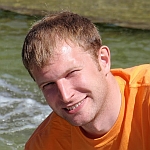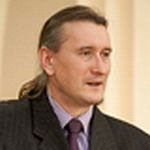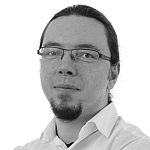Vaidas Adomauskas 



http://scrum.agile.lt |
Vaidas works as a Product Manager and Scrum Coach in Adform. He was part of the Scrum implementation team. Now he is responsible for one of the company key product as well as every day review and improvements of Scrum in Adform. Before returning to Lithuania he helped to implement Scrum in Lavasoft (Sweden). Vaidas is sharing his experiences in scrum.agile.lt blog, gives presentations in international and Lithuanian IT/Agile conferences, as well as consults/runs trainings for companies implementing Agile methods. He is initiator of Agile Lithuania community, Agile and Scrum user group meetings, and Agile conferences in Lithuania. He is certified Scrum master (CSM), certified Scrum product owner (CSPO), and member of Lithuanian project management association (LPVA). Vaidas is teaching “Agile Project Management with Scrum” course in Vilnius University. Starting Agile in a company: tips how to organize projects/products portfolio and cross-functional teamsNo doubt, companies have optimized their processes and structure according to the needs of traditional software development methods. The ones that start using Agile methods understand, that the they need to change management of projects/products portfolio as well as teams composition to get the full value of Agile. This very often means company organizational structure changes. In the presentation I share my experience gathered while changing structure of two organizations to be applicable for Scrum. I give advices how to organize project/product portfolio, so that company could respond to clients requests quickly, do all support work, and do not to multitask (which is one of the greatest bottlenecks for efficiency). I will also give few tips how to organize the work so that it could be accomplished by stable teams. Practice shows that stable teams become up to few times more productive that “project teams” created for each project. Do you want to achieve the same in your organization? Come to listen! 
Starting Agile in a Company
View more presentations from Vaidas Adomauskas |
Ričardas Kunevičius 
|
Managing director and product owner at UAB E-Bros. 10+ years in the project management field. Already 12 month managing agile company. Strategy implementation sprint by sprintSCRUM is fast, really fast and it’s hard to control the BIG picture in constantly changing environment. We have tried couple of approach here. Some failed and some are on the way. I will present our efforts to transform classical project portfolio to suite better agile environment. |
Vitālijs Jakovels Armands Baranovskis 
|
Vitālijs has been working in the Information Technology industry for 7 years. He has participated in several large government IT projects as Functional Consultant and Project Manager. Currently Vitālijs is a Project Manager at Tieto Latvia, where he is involved in the State Education Information System Improvement Project of the Ministry of Education and Science of the Republic of Latvia. His main professional interests are project management and agile practice implementation. Armands has been in the Information Technology industry for 9 years and has been working with ERP and Billing Systems as project manager and solution architect for more than 6 years. Currently Armands is solution architect in a recently founded company eBIT SIA. His main professional interests are SOA development and agile practice implementation. He is also guest lecturer at Riga Technical University and Riga Business School. Armands has also been a presenter in several conferences in Riga. Successful collaboration in Agile projects. Practical issues and cooperation experience between eBIT and TietoAgile practice is used very successfully in cases of small co-located teams. It becomes more complicated if there are several teams from different locations, vendors etc. Having experienced quite a few agile projects, we would like to share some pointers on collaboration with subcontractors as well as clients that may help to experience another agile success story rather than a failure: Contract - what you should not forget to agree on Educating clients and suppliers - investment in education brings rewards Regular tracking - know where you are Transition to support – the last but not the least important phase in the project As a good example we would like to tell about our experience in a project working with Tieto, where Tieto is the prime vendor and eBIT is a subcontractor. |
Lasse Ziegler |
Lasse Ziegler is an agile coach and trainer with many years of experience working with different scrum teams in a variety of organizations both small and large. In the last 12 years Lasse has been a developer, architect, project manager, CTO and entrepreneur. Having been in different roles gives a coach good overview of different aspects of an organization as well as an understanding of their different needs. With this experience a coach is well equipped in delivering a end-to-end coaching experience where both the business as well as the development are engaged. As part of agile42 Lasse offers coaching and training in agile and lean. For agile42 coaching is not equal consulting. We do not tell you what to do, we make you find the right solution yourself and enable you to retrospect and optimize your processes. If you want to accelerate the implementation of a new method like Scrum, Kanban etc. we recommend beside our interactive trainings our effective on-the-job coaching. Read more about us at: http://agile42.com Agile Transitions - Things to consider before you startAgile transitions do not only change how a development team works but how the whole organization is structured, how it behaves and how it runs its product portfolio. This makes the transition have a significant financial risk and can not just be done by sending the team to one two day course. What things should you keep in mind when doing an agile transition? This talk will try to give some basic pointers on how to start a transition in a way that will greatly reduce the risk of failing to achieve the aimed for results. Agile Transitions @Agile Tour Vilnius 2011
View more presentations from Lasse Ziegler |
Alexey Krivitsky 


|
Alexey is a founder of Agile Ukraine community. He is also a founder and frontman of Agile Eastern Europe and Agile Base Camp conferences. Since 2008 he has been working co-training a majority of the Certified ScrumMaster classes in Ukraine. In 2009 has invented one of the earliest Scrum Lego simulations. Talking about hobbies, Alexey is a bass player and a ski freerider. Offshore Outsourcing with Scrum. A body of knowledge on managing offshore teamsBased on the blog: www.scrumoffshore.net. For whole my career – from a developer to a team lead to an agile coach – the vast majority of the projects I’ve been involved in have been dealing with offshore software development. A poor guy, one can say. Maybe. But I’ve learned a lot! In major cases I saw development teams that are geographically separated from the product management. In some other cases there were native teams were seating close to the product people, whereas the unlucky ones were spread across the globe. I’ve seen both successful and disastrous projects in terms of the ways communication and coordination was designed. I saw people being pretty much on the same page in terms of project goals while seating in different offices and in different countries. And I saw people being completely off the track, suffering and losing motivation. For the last five years I’ve been collecting mental memories of what made some projects good places to be and some not-so-good ones. Now with a ever-growing market of offshore development in the Eastern Europe, I see a need to integrate what I’ve seen and try to make it beneficial for the industry. To let people know how to do it properly to avoid the aches. Being interested in the Eastern philosophy I’ve come across a mantra – a mantra of offshore development which sounds like: THINK TWICE. START IT UP. SPEED IT UP. SCALE IT UP. If you are more a Western-minded person, you can think of a formula rather than a mantra. Then T2S3 is your answer In this talk I will present a pattern-based framework for organizing offshore work. Namely, a set of advices on how one should go about working with offshore development teams from the very first steps like hiring up to the advanced things like optimizing and scaling. All of that will be presented with the Agile mindset. And the Scrum as a core framework for dealing with complexity, teams and culture of improvements. While waiting for the conference and my talk, check out the blog www.scrumoffshore.net where I’ve started to elaborate the ideas. |



 Sydney
Sydney Vienna
Vienna Aracaju
Aracaju Montréal
Montréal Santiago De Chile
Santiago De Chile Beijing
Beijing Vilnius
Vilnius Kinshasa
Kinshasa Brescia
Brescia Bordeaux
Bordeaux Dublin
Dublin Bengaluru
Bengaluru Osaka
Osaka Luxembourg
Luxembourg Ifrane
Ifrane Bucharest
Bucharest Genève
Genève Kiev
Kiev Philadelphia
Philadelphia Mérida
Mérida Ho Chi Minh City
Ho Chi Minh City
 I like AgileTour
I like AgileTour






